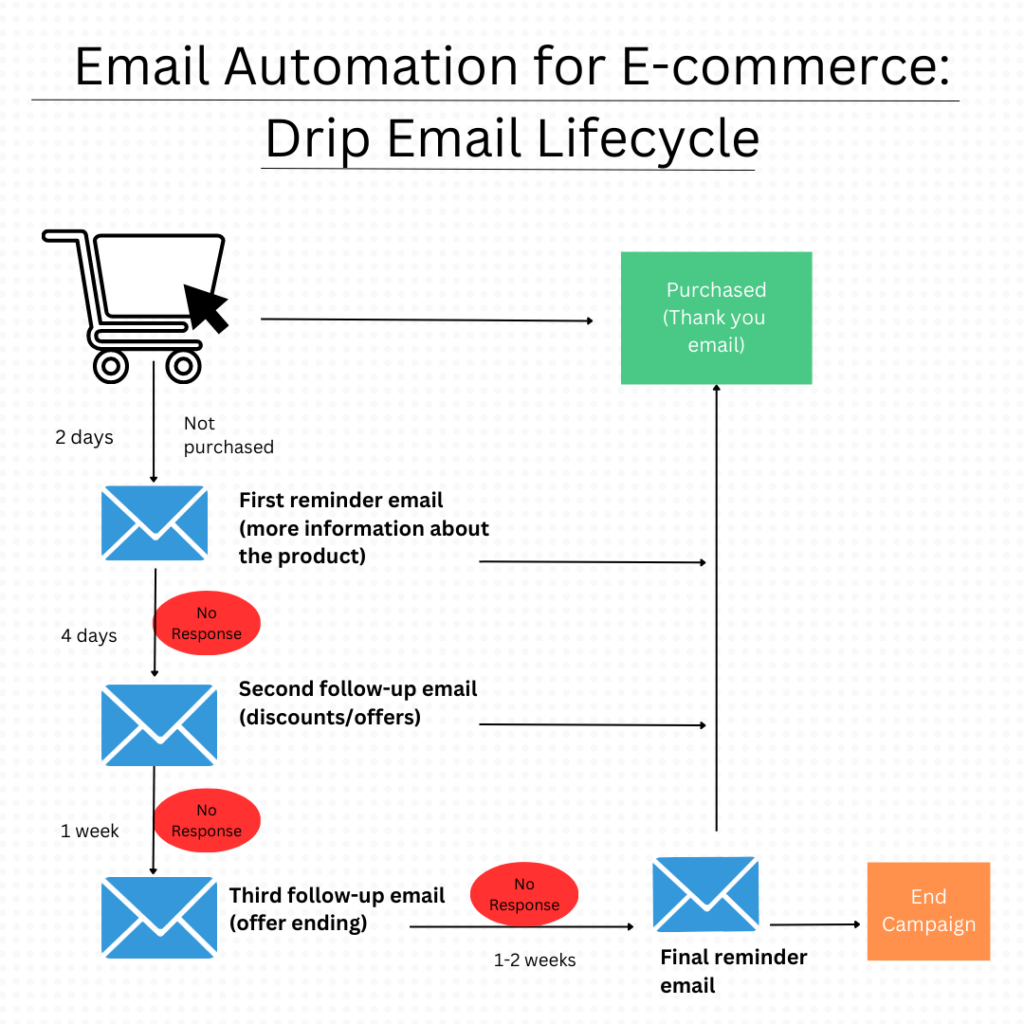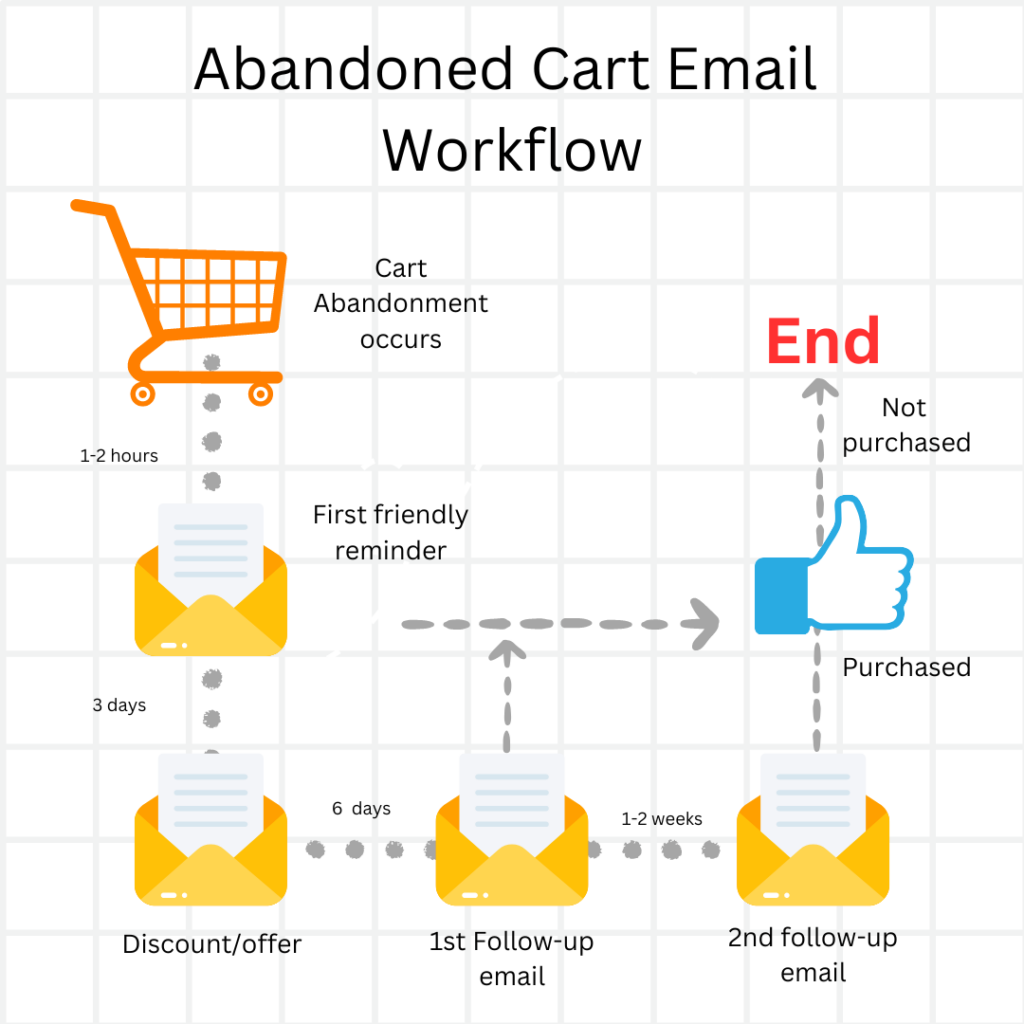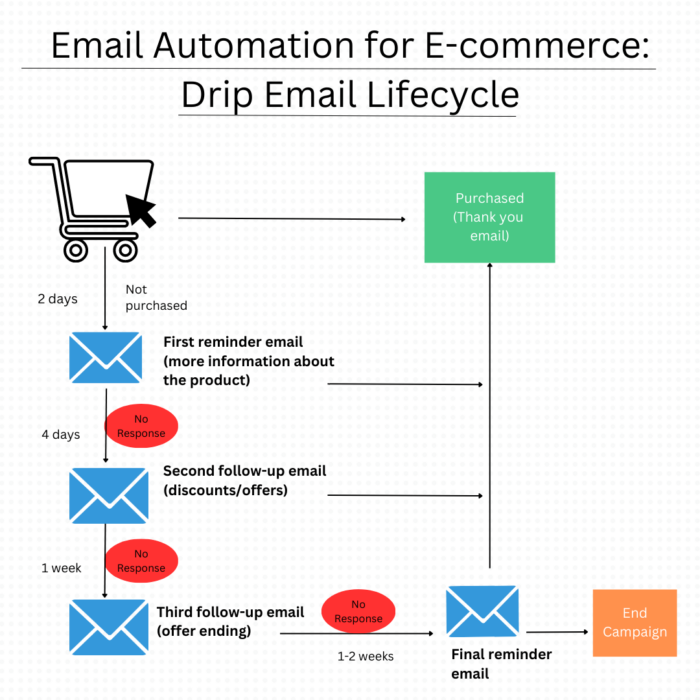As an eCommerce business owner, you probably want to increase your online sales. You can do this via effective email communication.
However, email is a tool used by all businesses. So, how can you use it to stand out from your competition? Well, simply by leveraging email automation to elevate your email communication.
In this post, we will cover everything about email automation for e-commerce. But before that let’s dive deep into why should you use email automation in the first place.
Table of contents
1.Why use email automation for e-commerce?
2. How to use email automation for e-commerce?
3. 5 must-have email automation templates for e-commerce
3.1 Welcome emails
3.2 Abandoned cart emails
3.3 Follow-up emails
3.4 Re-engagement emails
3.5 Upsell emails
4. Conclusion
Why use email automation for e-commerce?
Email is a highly versatile and widely used mode of communication that is not restricted to any particular platform or social network. It offers a direct and straightforward way of messaging, and it has the ability to evolve and adapt to changing market trends.
However, creating effective email campaigns requires a lot of effort. It’s not practical to write individual emails for each client, nor is it a good idea to send generic emails to the entire database.
Here, email automation comes to the rescue. You can efficiently analyze campaign data, personalize your emails based on demographics, social, and transactional data, and tailor segments for your marketing strategy.
Email automation also helps build consistency and engagement with your customers by delivering messages at the right time and creating brand recall for your e-commerce business.
Moreover, automation frees up time for developing content and maintaining brand consistency across all customers.
How to use email automation for e-commerce?
As an e-commerce business, it’s crucial to nurture leads. So, your automated drip email campaigns take a central spot here.

Here are some best practices to use email automation for e-commerce:
Identify your goals:
Determine what you want to achieve with your email automation campaigns. Is it to increase sales, improve customer retention, or promote new products?
Segment your audience:
Divide your email list into smaller groups based on demographics, past purchase behavior, and engagement levels. This will help you tailor your emails and increase their relevance to each group.
Personalize your emails:
Use customer data to personalize your emails, such as including their name, past purchase history, or product recommendations based on their browsing behavior.
Test and optimize:
Monitor the performance of your email campaigns and make adjustments to improve open rates, click-through rates, and conversions. Test different subject lines, images, and calls to action to see what works best.
Monitor and improve deliverability:
Ensure your emails are delivered to your subscribers’ inboxes by regularly monitoring your email deliverability rates and taking action to improve them if necessary.
By following these steps, you can leverage the power of email automation.
Along with these best practices, take a look at these 5 automated emails that every e-commerce business must have in its email workflow. It will help you improve the effectiveness of your e-commerce email marketing and ultimately drive more sales and revenue.
5 must-have email automation templates for e-commerce
1. Welcome emails
Welcome emails have an impressive open rate of 50%, which is much higher than promotional emails.
This presents a valuable opportunity for businesses to engage with interested shoppers who are not yet ready to make a purchase.
These individuals are potential customers and are therefore ideal for further communication in the hopes of converting them into buyers later.
2. Abandoned cart emails
The majority of online shopping carts are abandoned, with a staggering 81.4% of cases. This contributes to a major loss of revenue. Isn’t it?
That’s why having the plan to address cart abandonment is crucial, including the use of automated cart abandonment emails.
To maximize effectiveness, consider sending a series of reminder emails to customers, featuring images of the abandoned products, and incentives such as low-cost perks and a direct link to the checkout page.

3. Follow-up emails
The sales technique of following up with customers has stood the test of time. Not just for e-commerce businesses but others too.
It communicates to customers that you care for them as well as demonstrates ongoing concern for their satisfaction, even after payment has been received.
4. Re-engagement emails
A significant portion of the email lists of e-commerce businesses consists of disengaged audience members who have not made any purchases.
However, these individuals are not a lost cause, as they are already familiar with the brand, making them a “warmer” audience than strangers.
The key is to utilize re-engagement prompts to encourage them to return to the website and make a purchase.
5. Upsell emails
The importance of upselling can’t be stressed enough, especially for e-commerce businesses.
It is without any doubt an effective strategy to boost revenue and foster repeat purchases.
Utilizing automation and triggers to tailor the content of the offer can increase its relevance and maximize its impact.
Conclusion
Being an e-commerce business, automated emails can significantly reduce your workload. You can easily send triggered emails to targeted leads and customers at the most opportune times, ensuring that the messages are highly personalized and effective in producing results.
FAQs
Q. What are the key benefits of email automation in e-commerce?
A: Email automation offers benefits such as time savings, improved customer segmentation, increased open and click-through rates, better customer retention, and the ability to deliver relevant content.
Q. How does email automation work for e-commerce?
A: Email automation involves setting up predefined workflows or sequences triggered by specific customer actions or events. These triggers can include actions like making a purchase, abandoning a cart, or signing up for newsletters. Once triggered, automated emails are sent to the customer based on the predefined criteria.
Q. What types of automated emails can benefit e-commerce businesses?
A: Common types of automated emails include welcome emails, abandoned cart emails, order confirmation emails, product recommendations, and re-engagement emails. These targeted messages help improve customer experience and encourage repeat business.
Q. Can I personalize automated emails for my e-commerce store?
A: Yes, personalization is a key feature of email automation. You can customize emails based on customer data such as purchase history, browsing behavior, and demographics. This personal touch enhances the relevance of your emails and increases the likelihood of customer engagement.
Q. How can email automation help with customer retention in e-commerce?
A: By sending personalized and timely messages, email automation helps build stronger relationships with your customers. You can use it to send loyalty rewards, exclusive offers, and relevant content, keeping your brand top-of-mind and encouraging repeat purchases.
Q. Is it necessary to segment my email list for automation?
A: Yes, segmenting your email list is crucial for effective email automation. By categorizing your audience based on factors like purchase history, preferences, and behavior, you can create highly targeted and relevant email campaigns that resonate with specific segments of your customer base.
Q. How can I measure the success of my email automation campaigns?
A: Track key metrics such as open rates, click-through rates, conversion rates, and revenue generated from your email campaigns. Most email marketing platforms provide analytics tools to help you assess the performance of your automated campaigns and make data-driven improvements.
Q. What are some best practices for implementing email automation in e-commerce?
A: Start with a clear strategy, carefully segment your audience, use compelling and personalized content, optimize your timing, and continuously analyze and refine your campaigns based on performance data. Regularly update your automation sequences to adapt to changing customer behavior and preferences.


Leave a Reply